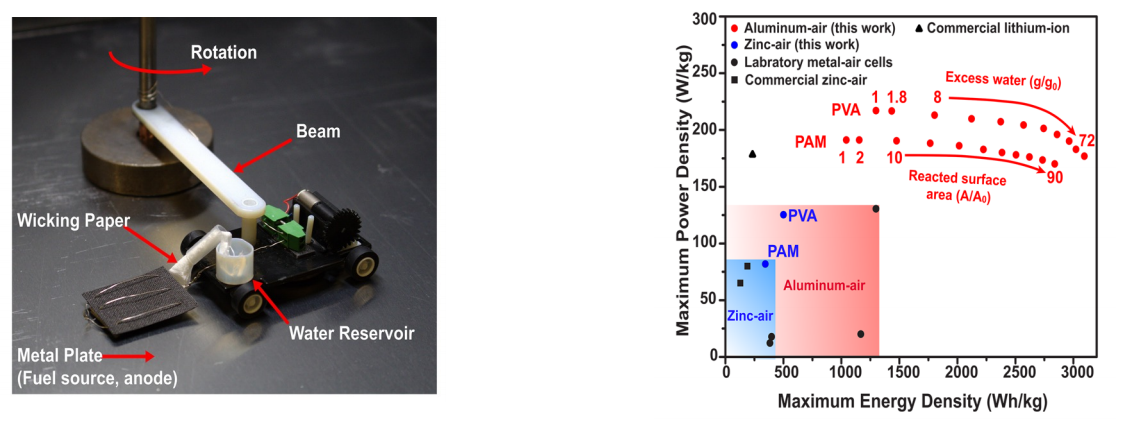Nextgen robots can ‘eat’ metal for energy A metal-air scavenger for powering robots, vehicles, and electronics. Mobile robots are beco...
 |
| Nextgen robots can ‘eat’ metal for energy |
Robots are predicted to streamline a multitude of industrial processes, including those involved in the manufacture and design of therapeutic devices and drugs. However, this next generation of robots will need an independent, continuous, and economical source of power to do so. The most common power source used presently are batteries, and whilst these are simple to use, they are known to run down quickly when powering larger robots, with the extra weight shown to drain units more rapidly.
The next option, mains operated electricity, where more energy can be supplied, has fallen at hurdles involving mobility with permanently connected wires becoming tangled when the robot is moving around. Another option entails the ‘harvesting’ of energy through the adoption of devices such as solar panels or vibration harvesters to collect potential from their environment, however, these only work in certain conditions, and may lack the capacity to supply electricity continuously to larger robotic entities.
In addition to storing energy, there are technologies that allow devices to extract energy from their environment, but these tend to have low power and require specific environmental conditions. We have developed a technology than can power electronics by “consuming” metal from external surfaces and “breathing” oxygen from the air.
Now, a study from researchers at the University of Pennsylvania engineers next generation scavenger technology possessing the capability to enable robots to ‘eat’ metal for energy. The team states their ‘Metal-Air Scavenger’ (MAS) works like a battery, providing power by repeatedly breaking and forming a series of chemical bonds in metal and air, however, it also works as a harvester gathering energy from its environment. The study is published in the journal ACS Energy Letters.
Previous studies show technologies encompassing the mechanized parts of a robot and their memory are disproportionate to the electrical components responsible for powering them when miniaturization is factored into the equation. This is because as hardware shrinks so do batteries leaving them with fewer bonds to break; due to the fact, the density of these bonds is fixed throughout any material, meaning robots operate for less time.
One solution for this imbalanced relationship comprises foraging for chemical bonds via harvesters capable of collecting solar, thermal, or vibrational energy. These are particularly useful for robots in remote areas, enabling autonomous mobility. However, harvesters possess low energy density, the ratio of available potential versus the weight carried, meaning they can’t collect power quickly enough for the robotic unit.
The current study develops a MAS whose energy density is more than that of the best-known harvesters, endowed with the ability to compete against batteries without the associated weight issues.
Rather than a battery, the researchers’ metal-air scavenger vehicle gets energy from breaking chemical bonds in the aluminum surface it travels over. The vehicle keeps going until the hydrogel slab it’s dragging dries out or the surface is completely corroded, but a freely moving robot could seek out new sources of water and metal.The current study engineers a MAS robot powered by a cathode connected to a small motorized vehicle containing a slab of hydrogel and extra water responsible for conducting electrons harvested from the metallic-based food source. Results show the hydrogel acts as an electrolyte enabling electrons to flow from the surface of the metal to the cathode to power the connected device.
Data findings show the MAS vehicle oxidized the metallic surfaces it traveled over, leaving a layer of microscopic rust behind it. The lab states even with the extra water weight the MAS has ten times more power density than the top harvesters on the market and thirteen times more energy density than lithium-ion batteries.
They go on to add the MAS vehicles were also trialed using zinc and stainless steel as ‘food’ with different metals shown to afford varying energy densities dependent on their oxidation number. They conclude their MAS is similar to a battery, breaking and forming chemical bonds repetitively, yet performs like a harvester foraging energy from its environment. The team surmises they have developed a robot capable of ‘eating’ metal and air in its environment to power itself.
For the future, the researchers state their robot could herald the inception of autonomous machines adapted to eat and digest organic and non-organic substances in their environment to continuously power themselves, whilst mimicking the human digestive system.










